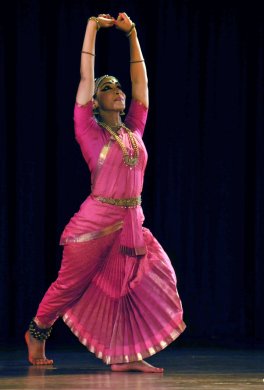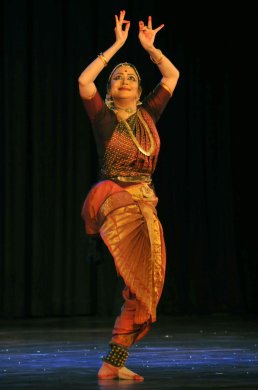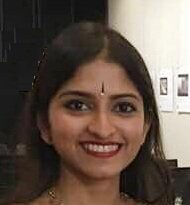
|   |

|   |
New afternoon slot at the Music Academy - Sukanya Kumar e-mail: sukanya.kumar91@gmail.com Photos: Thanthoni February 4, 2020 A new feature introduced this year at the Annual Dance Festival (Jan 3 - 9, 2020) of The Music Academy, Madras, is the 2pm slot apart from the usual morning and evening sessions. Jyotsna Jagannathan  Jyotsna Jagannathan, trained under A. Lakshmanaswamy and Bragha Bessell (for padams and javalis), presently mentored by Malavika Sarukkai, presented a traditional margam. She commenced with a Mallari in Gambheera Nattai set to misra triputa talam. "The movements are inspired by temple processions comprising of drums, elephants, trumpets and dancers," was the announcement. She covered the vast stage with unhurried strides, resembling a grand procession. The oft seen Varnam 'Mohamaginen' in Karaharapriya set to adi talam, a composition of Dandayudapani Pillai incorporated lengthy jathis. Jyotsna depicted the Nayika adorning herself as Lord Shiva, losing herself in the beauty of resultant form and embracing it, in the sanchari for the pallavi, "Mohamaginen inda velayil.' In the arudi of the Chittaswaram, mridangam vidwan K P Ramesh Babu played the kanakku of the Purvangam while Jyotsna danced the kannakku of the Uttarangam. Her dramatic gestures embellished the arudi that landed on the words "maathe innum yosanai yenadi." The choreography was well structured and presented in a neat manner. The sonorous strings of the violin set the perfect mood for "Yahi madhava yahi Keshava," the ashtapadi that followed. The intelligent lighting control by Venkatesh Krishnan was explicitly visible in the opening segment of the ashtapadi when Radha lights one lamp after another and the stage light brightens gradually with it. Mahesh Swami's score on flute was apt and poised in the indication of Krishna's arrival on the scene. The piece was delineated by Jyotsna with emotive involvement. The intimacy between Krishna and the other woman when he applies kajal in her eyes was tastefully portrayed. The concluding Tillana began in an interesting line, "baaj paayal kaho," where Jyotsna entered miming the ghungroo sounds. After an unexpected crisp jathi, vocalist Binu Venugopal melodiously sang the 'jhanana jhanana' verse, going into the Pallavi of the tillana in ragam Dhanashree composed by Maharaja Swati Tirunal. While Binu's mellifluous rendition and command over Sanskrit embellished the performance, a little attention to Tamil and Hindi pronunciation would have made it flawless. Easwar Ramakrishnan on violin intelligently introduced the refrain 'tadheem tadheem dhirena' in the pauses of the preceding line. A better coordination between the mridangam vidwan and the footwork of the dancer would have enhanced the rhythmic content of the presentation. A well balanced robust nattuvangam by Sudarshini contributed to the aural appeal of the program. The visually comforting aharya added to the aesthetics of the dancer's movements. Pavithra Srinivasan  It is always blissful to watch a performance that transcends technique. Pavithra Srinivasan's margam was one of that kind. She commenced with the invocatory piece, Hanuman Kauthvam composed by Dr. Ghatam Karthik in Ragamalika, khanda chapu talam where her poses of Anjaneya loomed large extending beyond her physique. The signature refrain 'Taka jhom taka nam taka dheem' was executed with comforting movements that brought the audience back to a focal point, rooting the piece in talam, that was well rendered by Jayashree Ramanathan on nattuvangam. Swarajathi in ragam Khamas, talam adi, a composition of Chinnakrishna Dasar, followed next. The comprehensive choreography by Pavithra for this Swarajathi depicted Lord Shiva as the king of Kailash, Neelakantha, Kalasamhara, Tripurasamhara, the one who brings Ganga as Vaigai river flowing around the city of Madurai, he who bestows Moksha. Staying sensitive to the verse referring to the lord as 'Sambashiva,' she consistently portrayed multiple images of Shiva in the company of his consort and family. The sancharis depicting the Yatra to Kailash, Devas coming down to Mansarovar, and the different faces of Mt. Kailash from different directions, all painted a picturesque imagery with a balanced combination of spiritual yogic bhakti and practical expressions, like battling the cold. In the episode of Kalasamhara, young Markandeya was shown hugging Shivalinga, not because of the fear of death but because he wants more time to complete his prayers. The Neelakanta section was from Vasuki's perspective, expressing his plight and discomfort before coughing up poison. Intricate and specific gestures were used to represent the Tripurasuras and the Tripurasamhara. All these were examples that proved the research, thoughtfulness, and comprehension of the subject at its micro level. The ending of the Swarajathi with Om Namah Shivaya was serene and conjured a powerful calm closing image to the piece. Kshetrayya's "Valapudasanerane O Bhama!" set in ragam Varali and misra chapu talam, dance choreography based on teachings of Nithyakalyani Vaidyanathan, where the nayika is hankering for Krishna, was presented next. When the Sakhi disapproves wearing her heart on the sleeve, the nayika, in her defense, says that Krishna's love spell makes her run to him without hesitation. Pavithra's delicate and subtle expressions with intentional yet instinctive eye movement, was visually pleasing. Pavithra concluded with a story from Panchatantra which is a Neetishastra, an interesting dance adaptation of perhaps one of the oldest folklores of India. The medium of storytelling employed by Pt. Vishnu Sharma to educate the princes was used effectively to employ Bharatanatyam vocabulary to present an easy to understand story of the 'Ant and the Pigeon.' The music composed by Hariprasad opened with an apt Tanam to introduce the character of the ant. The actions illustrating 'a leaf falling,' 'the ant thanking the pigeon,' and 'the hunter walking,' were some specific examples of innovative use of natya hastas and lokadharmi in Pavithra's choreography. Jayashree Ramanathan on nattuvangam, Hariprasad on vocal, N. Nagarajan on mridangam, Shashidar on flute, and Anantha Narayana on veena enhanced the effectiveness of the production greatly. Pavithra's performance and perceptive choreography provided for an afternoon of simple, crisp and involved presentation. Purva Dhanashree  Purva Dhanashree, trained under veteran Vilasini Natyam artiste Swapnasundari, presented a beautifully knit repertoire. She commenced with Shabda Pallavi in ragam Anandabhairavi and talam adi with elaborate footwork combined with precise hand and eye gestures tracing arched lines. The grace and fluidity in her movements presented an energetic start to the program. Varnam "Sarasijakshulu" in ragam Kalyani set to roopaka talam, a composition of Sivanandam Pillai of the Tanjore Quartet, incorporated jathis that were both comprehensive and crisp, a rhythmic composition of Ramamoorthy Sriganesh. The delineation of the cupid's arrows was innovative with touches of surprise despite it being a repetitive motif in the second half of the piece. The unhindered ease in the transitions from sahityam to swaram was specially comforting to watch. Purva Dhanashree next presented a Padam, "Aadadani janmamettina phalamemi" in ragam Sahana set to misra chapu talam, a composition of Kasturi Ranga. The lonely nayika questions her very existence, "What is the use of living if I cannot be with the man I love?" The innocence of the nayika who in her childhood was not permitted to study, whose world revolved around family was well portrayed with powerful metaphors of 'Chekkula kattina maadu,' an ox tied to the wheel. The sanchari for the line 'Satatamu pati bhakti' was rendered with sensitivity, especially notable was the depiction of 'fake' pooja, the imagery of a bird inside a cage and the mundaneness of the nayika's existence. She concluded with a keertanam 'Gayati Vanamali' in Yaman Kalyani ragam set to adi talam, penned by Sadashiva Brahmendra. The musical composition by Dr. M Balamuralikrishana was a delight in itself, while the rhythmic composition by Ramamoorthy Sriganesh was unobtrusively apt. The depth and sincerity in her bhakti were evident in the simplicity of her expressions. Her eyes conveyed great emotional maturity with a million emotions at once, while her physical dancing was kept minimalistic. The poignant end conveying the act of renouncing was well supported by the orchestral choice of stopping one instrument at a time until it was all silent, culminating in quietude. With seasoned artistes like Jayashree Ramanathan on nattuvangam, Nandini Sharma Anand on vocal, Ramamoorthy Sriganesh on mridangam, Nandini Sai Giridhar on violin, and Shruti Sagar on flute, the orchestral support was very effective in adding to the sensorial experience of the presentation.  Sukanya Kumar is a practitioner of Bharatanatyam and Kathak genres trained under illustrious gurus. She is a Creative Culturist, and choreographer skilled in implementing electronic media technology in her productions to propagate social messages. She has a BSc in electronic media, MFA in Bharatanatyam, MBA in Educational management and MFA in Dance and Technology. |